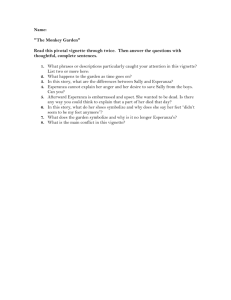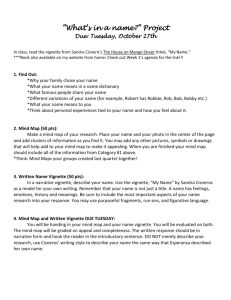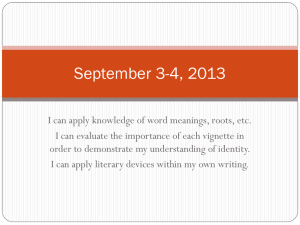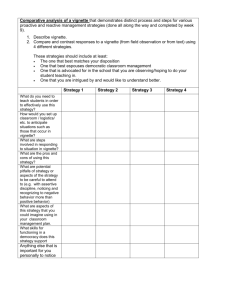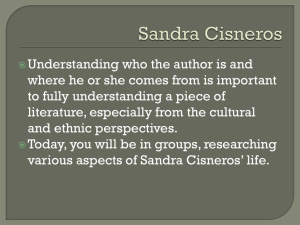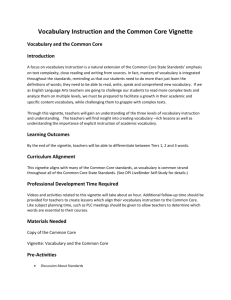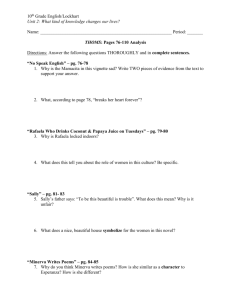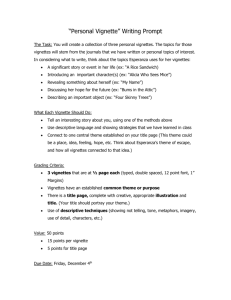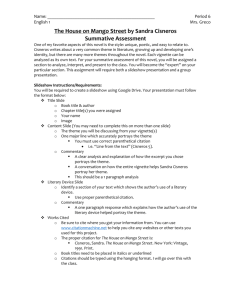The House on Mango Street Focus Questions
advertisement
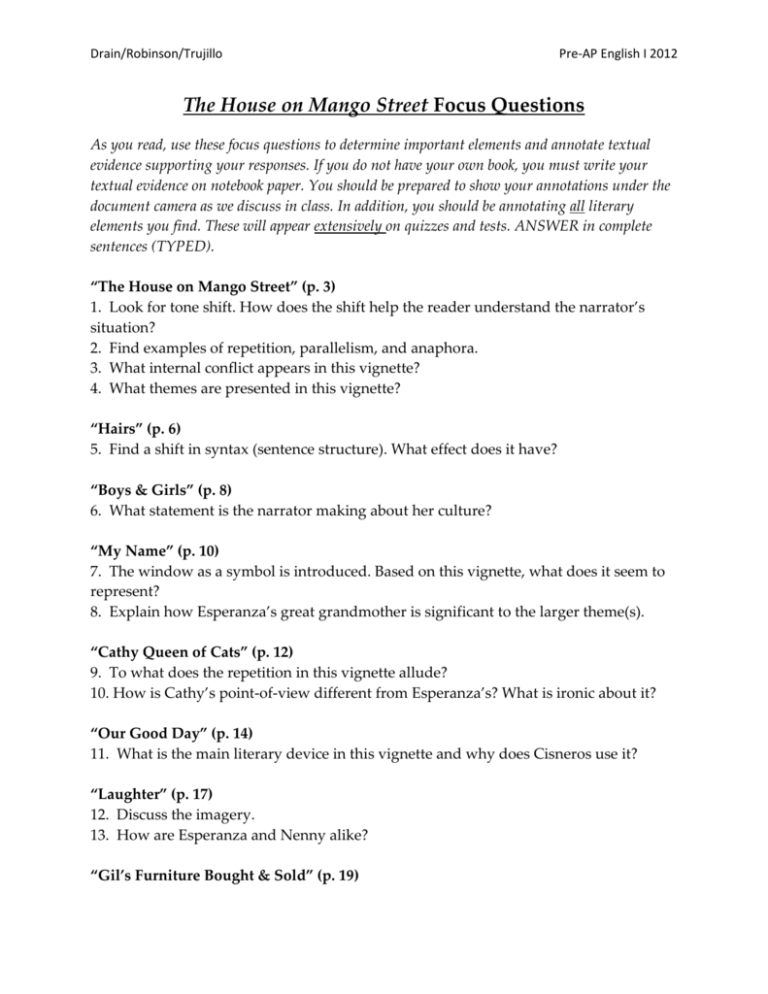
Drain/Robinson/Trujillo Pre-AP English I 2012 The House on Mango Street Focus Questions As you read, use these focus questions to determine important elements and annotate textual evidence supporting your responses. If you do not have your own book, you must write your textual evidence on notebook paper. You should be prepared to show your annotations under the document camera as we discuss in class. In addition, you should be annotating all literary elements you find. These will appear extensively on quizzes and tests. ANSWER in complete sentences (TYPED). “The House on Mango Street” (p. 3) 1. Look for tone shift. How does the shift help the reader understand the narrator’s situation? 2. Find examples of repetition, parallelism, and anaphora. 3. What internal conflict appears in this vignette? 4. What themes are presented in this vignette? “Hairs” (p. 6) 5. Find a shift in syntax (sentence structure). What effect does it have? “Boys & Girls” (p. 8) 6. What statement is the narrator making about her culture? “My Name” (p. 10) 7. The window as a symbol is introduced. Based on this vignette, what does it seem to represent? 8. Explain how Esperanza’s great grandmother is significant to the larger theme(s). “Cathy Queen of Cats” (p. 12) 9. To what does the repetition in this vignette allude? 10. How is Cathy’s point-of-view different from Esperanza’s? What is ironic about it? “Our Good Day” (p. 14) 11. What is the main literary device in this vignette and why does Cisneros use it? “Laughter” (p. 17) 12. Discuss the imagery. 13. How are Esperanza and Nenny alike? “Gil’s Furniture Bought & Sold” (p. 19) Drain/Robinson/Trujillo Pre-AP English I 2012 14. What is the significance of the box? “Meme Ortiz” (p. 21) 15. Discuss the imagery. “Louie, His Cousin & His Other Cousin” (p. 23) 16. What are some of the literary elements used to characterize Louie? “Marin” (p. 26) 17. Find one line that displays a theme of the book. 18. Discuss how Marin is characterized. “Those Who Don’t” (p. 28) 19. Who are “those who don’t”? 20. What is Cisneros saying? “There Was An Old Woman …” (p. 29) 21. What does Angel Vargas do? Why? “Alicia Who Sees Mice” (p. 31) 22. Explain how cultures collide in this vignette. “Darius & the Clouds” (p. 33) 23. How is Darius characterized? “And Some More” (p. 35) 24. What do you think? “The Family of Little Feet” (p. 39) 25. Shoes are a motif used throughout the book. What do they symbolize here? 26. How are allusion and metaphor used in this vignette? 27. What can you infer about the men on the corner? “A Rice Sandwich” (p. 43) 28. Recall the nun in the first vignette and compare with the nuns here. Why do you think Cisneros portrays them this way? 29. How is Esperanza’s experience different from what she had imagined? “Chanclas” (p. 46) Drain/Robinson/Trujillo Pre-AP English I 2012 30. Discuss how the shoe motif is used in this vignette and compare to its use in “The Family of Little Feet.” “Hips” (p. 49) 31. What theme(s) does this vignette explore? 32. What is Nenny’s role in this vignette? “The First Job” (p. 53) 33. First jobs usually make people feel grown up. What is Esperanza’s experience? “Papa Who Wakes Up Tired in the Dark” (p. 56) 34. How does Cisneros portray Esperanza’s relationship with her father? “Born Bad” (p. 58) 35. What imagery does Cisneros use to provide the reader with a vivid picture of Aunt Lupe? 36. Identify the tone(s) in this vignette. 37. What is the main conflict in this vignette? “Elenita, Cards, Palm, Water” (p. 62) 38. Discuss the irony in this vignette. “Geraldo No Name” (p. 65) 39. Who is Geraldo? 40. What techniques does Cisneros employ to explore a larger theme of the book? “Edna’s Ruthie” (p. 67) 41. How is Ruthie characterized? What can you infer from this? “The Earl of Tennessee” (p. 70) 42. What can you infer about Earl’s wife? “Sire” (p. 72) 43. What is the tone of this vignette? “Four Skinny Trees” (p. 74) 44. Discuss the extended metaphor used in this vignette. 45. What do the trees represent, and how does their use illuminate a theme of the book? “No Speak English” (p. 76) Drain/Robinson/Trujillo Pre-AP English I 2012 46. In what ways does Mamacita illuminate the experiences of all immigrants? 47. Discuss the power of language. “Rafaela Who Drinks Coconut & Papaya Juice on Tuesdays” (p. 79) 48. Discuss the symbolism of the window. Reflect on how it has been used throughout the book. “Sally” (p. 81) 49. How is Sally characterized? “Minerva Writes Poems” (p. 84) 50. How does Cisneros use Minerva to characterize Esperanza? “Bums in the Attic” (p. 86) 51. How does Esperanza identify with bums? “Beautiful & Cruel” (p. 88) 52. What is the tone of this vignette? 53. Discuss Esperanza’s view of the relationship between men and women. “A Smart Cookie” (p. 90) 54. How does this vignette illuminate a theme of the book? “What Sally Said” (p. 92) 55. What predictions can you make about Sally’s future? “The Monkey Garden” (p. 94) 56. To what does the Monkey Garden allude? Why is this significant? 57. Discuss the tone and how it shifts? “Red Clowns” (p. 99) 58. What can you infer? 59. What is the tone of this vignette? 60. Why is this vignette considered the climax or turning point of the book? “Linoleum Roses” (p. 101) 61. What does Esperanza realize about marriage? “The Three Sisters” (p. 103) 62. How is repetition used for emphasis in this vignette? Drain/Robinson/Trujillo Pre-AP English I 2012 “Alicia & I Talking on Edna’s Steps” (p. 106) 63. What does Alicia tell Esperanza? How does this illuminate a major theme of the book? “A House of My Own” (p. 108) 64. What does Esperanza finally realize? “Mango Street Says Goodbye Sometimes” (p. 109) 65. What does Esperanza realize about writing? Literary elements to annotate throughout The House on Mango Street: alliteration characterization inference metaphor oxymoron point-of-view symbol allusion hyperbole irony motif parallelism repetition theme anaphora imagery internal/external conflict onomatopoeia personification simile tone
